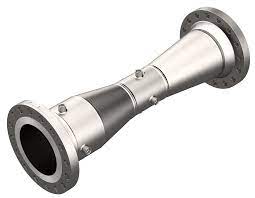A venturi tube also measures flow rates by constricting fluids and measuring a differential pressure drop. Venturimeter is a type of flowmeter that works on the principle of Bernoulli’s Equation.
Blog Contents
- Working Principle
- Parts of Venturimeter
- Venturimeter Equations
- Features of Venturimeter
- Types of Venturimeter
- Applications of Venturimeter
- Advantages of Venturimeter
- Disadvantages of Venturimeter
1. Working Principle
The pipe cross-sectional area is reduced to create a pressure difference which is measured with a manometer to determine the rate of fluid flow.
Venturi meter is a differential head type flowmeter.
In the upstream cone of the Venturi meter, velocity is increased, the pressure is decreased.
Pressure drop in the upstream cone is utilized to measure the rate of flow through the instrument
2. Parts of Venturi Meters
There are two tappings on the venturi meter for pressure measurement.
Upstream pressure tapping is located at a distance of one half of pipe diameter (D/2) upstream of the convergent entry.
Downstream pressure tapping is located in the throat (d/2) as shown in Fig.
Cylindrical Entrance Section:
Venturimeter entrance is a straight cylindrical section with a length equal to 5 to 8 times the pipe diameter.
Convergence Conical Section:
In this section, the venturi meter tube diameter gradually decreases. The conical angle is normally 210 ± 20. While the liquid flows inside the venturimeter, the velocity of fluid increases at the expense of a decrease in pressure.
Cylindrical Throat:
Throat consists of the minimum venturimeter diameter. In the throat section, the velocity is maximum and pressure is minimum. Normally, throat diameter = 1/3 to 1/4th of inlet pipe diameter.
Diverging Conical section:
At this section of venturimeter, the tube diameter gradually increases. So, the pressure is build up again to the original inlet pressure.
The cone angle is 5-70. British Standard BS-1042 specifies two conical angles, 5–70 and 14–150 for the outlet cone.
3. Venturimeter Equations
Bernoulli’s principle states the relation between pressure (P), kinetic energy, and gravitational potential energy of a fluid inside a pipe.
The mathematical form of Bernoulli’s equation is given as:
Where,
p= pressure inside the pipe
ρ =density of the fluid
g =gravitational constant
v = velocity
z=elevation or head
a = cross-sectional area of the pipe
d= diameter of the pipe
4. Features of Venturimeters
Design Pressure: No limitation. Limited by DP transmitter/ pipe press.ratings.
Design Temperature: No limitation. Limited by DP transmitter/ pipe pressure ratings
Sizes: 25 mm to 3000 mm
Fluids/ Applications: Clean Liquids/ clean gases
Limited applications: Dirty /corrosive/viscous Liquids & Dirty gases
Flow range: limited only by pipe size and beta ratio.
MOC: No limitation (cast iron/ carbon steel/ SS/Monel, Titanium, Teflon, Hastelloy, Naval Bronze/haste alloy)
Accuracy : It varies from ±0.25% to ±0. 75% of actual flow. The accuracy of DP transmitter varies from ±0.1% to ±0. 3% of full-scale error.
Rangeability is 3:1 to 5:1.
Upstream length/ Downstream straight length is 20 / 5
5. Types of Venturimeters
Normally three types of venturimeters are available:
Horizontal Venturimeter:
This type of venturimeter has the highest kinetic energy and the lowest potential energy.
Vertical Venturimeter:
This type has the maximum potential energy and the minimum kinetic energy.
Inclined Venturimeter:
Both potential and kinetic energy are in between the above two types mentioned.
6. Applications of Venturimeter
Venturimeters find wide application in fluid industries. The major application of venturimeters include7. Advantages of Venturimeters
Lower head losses than orifice plates reducing the capital expenditure on pumping eqpt. / save pump energy costs
No process interruption for the exchange of DP transmitter.
Can be used for temperature extremes
Cryogenics or High Temperatures
8. Disadvantages of Venturimeters
Highly expensive
Larger and heavier to handle.
Read more




